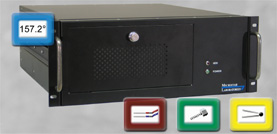
Temperature Measurement
When Off-the-Shelf Won't Work
NEWS FOR IMMEDIATE RELEASE |
|---|
|
For more information, contact |
Bellevue, WA, July 16, 2008 -- Off-the-shelf temperature measurement products do what they do very well. If they do what you want, by all means use them. If they don't have exactly what you need, take a look at the integrated thermal sensor tutorial and application pages Microstar Laboratories has just posted on the Web. The company's home page now includes a direct link to a new section of the site that shows you how to implement high-performance temperature measurement systems when off-the-shelf solutions won't work. You used to have to put in time and effort to pull this information together from various places on the Web, but now you can find it quickly and easily in one place: an integrated information source that complements an integrated system solution. You also can download the material formatted as a PDF file to print or to read off-line whenever you need it.
When Off-the-Shelf Won't Work
The new reference material describes what may make an off-the-shelf temperature measurement product less than ideal for your application. Possible issues are cost, packaging, display, integration, diversity, accuracy, speed, and noise. Microstar Laboratories makes Data Acquisition Processor (DAP) boards and network-ready DAPservers, and all solutions offered naturally include DAP boards – with an explanation of how you can resolve the particular issues listed above by using them.
DAP Boards and DAPservers
DAP boards make a robust platform for high-performance industrial temperature measurement systems. PCs and rack-mountable DAPserver system packages each can contain – and control – more than one DAP board. Every DAP board includes an onboard processor running a real-time operating system. Windows applications that support DLL calls can control a DAP board by communicating with this onboard operating system. You can control a DAP board from DAPstudio – a Windows application from Microstar Laboratories for data acquisition development – as well as from third-party (or your own) software, and you can do this from any PC on a network. For smaller systems, you can hook up a single DAPserver to any PC with an Ethernet connection. Or attach a keyboard and screen to the DAPserver and control it directly – using software preloaded at the factory. And, of course, a DAPserver does not have to be installed in a rack.
Temperature Measurement Details
Details covered in the new material include discussions on three main topics: on the appropriate class of sensor for each type of temperature measurement and given environment, on calibration and linearization, and on applications – including thermocouple, thermistor, and RTD examples. The application discussions specify typical hardware configurations and software routines that implement required system behavior at runtime. Hardware details include signal-conditioning products that conform to the company's channel architecture and that fit into standard 19-inch industrial enclosures with factory-installed backplanes, or that fit directly into DAPserver system packages that can be ordered with all required signal-conditioning boards pre-installed.
Conclusion and Next Step
When off-the-shelf temperature measurement products will not meet your requirements, you no longer have to invest time and effort into going through various PDF documents or white papers to determine what to do. The information you need is all in one place, online or downloadable. The solutions offered in the example applications all include DAP boards. You can download a free copy of DAPstudio to try it out. DAPstudio lets you control an application from anywhere on a network. To try out all its features, you need a DAP board. The company provides demonstration hardware at no charge.
# # #
Editorial Overview:
When off-the-shelf temperature measurement products cannot meet all of your needs for advanced temperature measurement systems, Microstar Laboratories, maker of Data Acquisition Processor (DAP) boards and DAPserver system packages, offers an alternative. The new integrated tutorial materials and application examples posted on the company web site show you how to implement a system that meets your needs. Other sources for this information are available but widely scattered – and Microstar has compiled a complete reference. Copies are available for download. Issues considered include cost, packaging, display, integration, diversity, accuracy, speed, and noise. Details covered include choosing sensors and signal-conditioning options, and example applications discussed include sample configurations using DAP boards and signal-conditioning boards made by the company.
Note to the Editor:
Microstar Laboratories suggests this text as a caption for the available image:
Check out guidelines on the Web on when to use an alternative to off-the-shelf temperature measurement products. A network-ready DAPserver with pre-installed signal-conditioning for thermocouple, thermistor, or RTD products provides a flexible alternative with the software you need preloaded. The icons in the image come from just-published pages on www.mstarlabs.com.
Microstar Laboratories, Inc. claims Microstar Laboratories, Data Acquisition Processor, DAP, DAPL, DAPcell, and DAPstudio as trademarks. Microsoft has registered Windows as a trademark. Other organizations may claim – or may have registered – as trademarks any trade names, logos, and service marks that appear in this document but not in the list above.
Microstar Laboratories makes it a practice to use an appropriate symbol at the first occurrence of a trademark or registered trademark name in a document, or to include trademark statements like this with the document.
